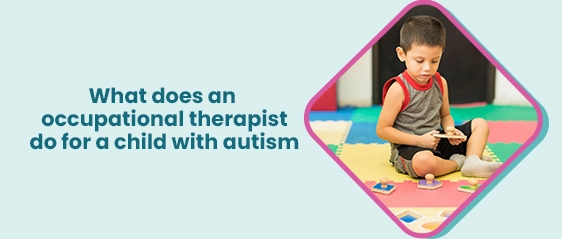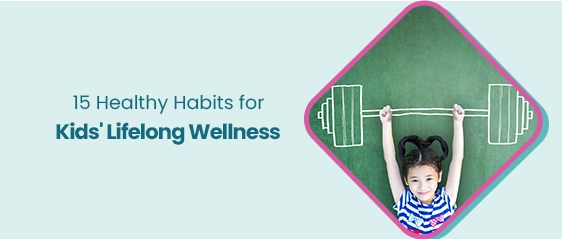
Occupational Therapy For Kids With Autism
- 14 Aug 2023
Autism can make some things harder for kids, like talking, playing, and doing daily tasks. But there's a special kind of helper called an occupational therapist (OT) who knows how to make things better. In this blog, we'll learn about what occupational therapists do for kids with autism and how they help them do things they might find tricky.
Occupational Therapy For Kids With Autism
Occupational therapists (OTs) are skilled professionals who play a vital role in supporting children with autism. These experts bring specialized knowledge and techniques to help kids with autism develop important skills that empower them to navigate daily life more confidently and independently.
What Occupational Therapists Do?
Occupational therapists are like superheroes who help kids with autism get better at everyday stuff. They help with things like how to handle things that feel strange, how to use their hands and bodies, how to take care of themselves, and how to talk and play with others.
Making Senses Stronger
Kids with autism might feel things differently because their senses are extra sensitive. Occupational therapists help them get used to different feelings, like sounds, textures, and lights, so they feel better and not too overwhelmed.
Getting Stronger at Moving
Some kids might find it hard to do things like writing, tying shoelaces, or even running and jumping. Occupational therapists help them practice these things so they get better at moving around and doing stuff by themselves.
Learning to Do Things on Their Own
Occupational therapists teach kids how to do things like getting dressed, brushing their teeth, and eating by themselves. These skills help kids become more independent and feel proud of what they can do.
Talking and Playing with Others
Sometimes, kids with autism find it tricky to talk to others or play together. Occupational therapists use fun activities and games to help them learn how to talk, make friends, and understand what others are saying.
Learning New Ways to Behave
Kids need to learn how to behave well, like managing their feelings, following rules, and handling changes. Occupational therapists help kids learn good behaviors and ways to calm down when they feel worried.
Special Help for Every Kid
Each kid with autism is special, so occupational therapists make a plan just for them. They work with families and teachers to help kids learn and do their best every day.
Making a Big Difference
Occupational therapists are like heroes for kids with autism. They help kids learn important skills, feel more confident, and do things they might find hard. With their help, kids can grow, learn, and become even stronger.
Occupational therapists have special skills to assist these kids in learning essential skills such as managing new feelings, moving better, doing tasks on their own, talking and playing with others, behaving well, and becoming more independent.
OTs work closely with families and teachers to create personalized plans for each kid. This collaboration ensures that the kids receive the right support at every step of their journey. Through their expertise, OTs make a significant impact by teaching valuable skills, boosting confidence, and helping kids become stronger.
If you're looking for the best occupational therapy doctor, remember that their guidance can be a game-changer in your child's journey toward progress and success. Their expertise can shape a brighter future for kids with autism, helping them grow, learn, and overcome challenges with confidence.
Frequently Asked Questions
1.Is walking good for high-risk pregnancy?
For some moms-to-be with high-risk pregnancies, walking can be good. But, before you start exercising, talk to your doctor first. They know what's best and safe for you and your baby
2.What does occupational therapy do for autistic kids?
Occupational therapy for autistic kids focuses on developing essential life skills. It helps improve sensory integration, motor skills, self-care routines, social interactions, and adaptive behaviors, enabling them to lead more independent and fulfilling lives.
3.Is OT effective for autism?
Yes, occupational therapy has shown to be effective for autism. It helps children improve their functional abilities, manage sensory sensitivities, enhance social interactions, and develop necessary life skills.
4.What are the occupational activities for autism?
Occupational activities for autism include sensory play, fine and gross motor skill exercises, self-care routines, social interaction games, and tasks that promote adaptive behaviors.
5.Which therapy is best for autism?
The best therapy for autism can vary based on individual needs. Speech therapy, behavior therapy, and occupational therapy are among the commonly recommended therapies for children with autism.
6.What are OT activities?
OT activities are exercises and tasks designed by occupational therapists to help individuals develop skills required for daily life. These activities can include tasks related to sensory integration, motor skills, self-care, social interactions, and more.
7.What are the three occupational activities?
The three main categories of occupational activities are self-care activities (like dressing and eating), productive activities (like school or work tasks), and leisure activities (like playing and hobbies).
8.What is speech therapy for autism?
Speech therapy for autism focuses on improving communication skills. It helps children with autism learn to express themselves, understand language, and engage in conversations.
9.What is behavior therapy for autism?
Behavior therapy for autism helps children develop positive behaviors and social skills while reducing challenging behaviors. It uses techniques to reinforce desired behaviors and teach new ones.
10.What are 3 treatments for autism?
Three common treatments for autism include behavioral interventions, speech therapy, and occupational therapy. These therapies address various aspects of autism and can be tailored to each child's needs.
11.What is the best age for autism therapy?
Early intervention is often recommended, so starting therapy as soon as signs of autism are recognized can be beneficial. However, therapy can be effective at any age and can be tailored to the individual's developmental level.
12.What are the 4 pillars of occupational therapy?
The four pillars of occupational therapy are evaluation, intervention, outcomes assessment, and ongoing reevaluation. These pillars guide the therapeutic process to ensure effective and individualized care.
13.How long is therapy for autism?
The duration of therapy for autism varies based on the child's needs and progress. Some children benefit from short-term intensive interventions, while others might receive ongoing therapy over an extended period.
14.How many hours of therapy is needed for autism?
The number of therapy hours needed for autism varies widely depending on the child's individual needs, severity of symptoms, and goals. Some children might have a few hours per week, while others might require more intensive therapy schedules. It's best to consult with professionals to determine the appropriate amount of therapy for each child.




